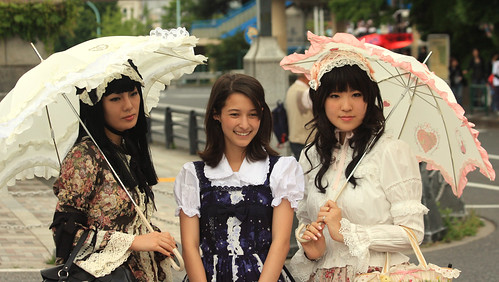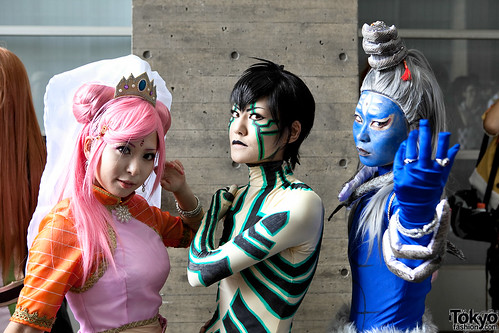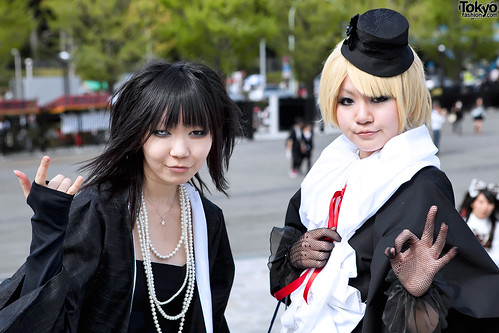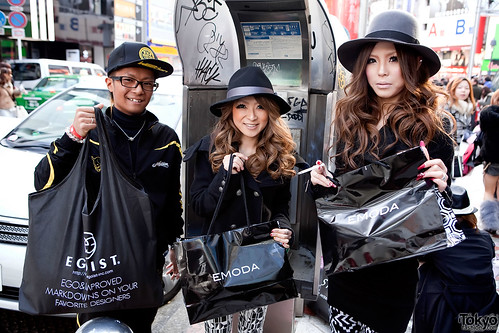7 Japanese Fashion Subcultures …
Japanese fashion scene is renowned for being anything from avant-garde to downright bizarre. What I find interesting is the number of subcultures present in Japanese fashion, and the way that people actively take part in each. In any of Japan’s main fashion districts, you’ll see a range of colourful street fashion. Below are just a few Japanese fashion subcultures to get acquainted with.
1. Mori Girls
 Photo Credit: frocksandfrolics.blogspot.com
Photo Credit: frocksandfrolics.blogspot.comThe Mori Girl subculture is one of the most recent Japanese fashion subcultures to have emerged. Mori Girls took to the scene as late as 2007. As mori means ‘forest’ in Japanese, the style of dressing revolves mainly around an earthy aesthetic. Quaint dresses in earthy tones best exemplify the Mori Girl. Loose layers, natural makeup, and vintage accents complete the look.
2. Ganguro
 Photo Credit: hippotoaster.com
Photo Credit: hippotoaster.comThe Ganguro style of dressing emerged in the mid 1990s and peaked in popularity around the year 2000. The look comprises mostly of bleached blonde or orange hair and deeply tanned skin. The clothing is bright and colourful and outfits consist of platform shoes, mini skirts, and stacked jewellery. Other styles of dressing, such as Yamanba and Manba developed from the Ganguro style. In recent years, the Ganguro style of dressing has died down.
3. Kogal
 Photo Credit: crunchyroll.com
Photo Credit: crunchyroll.comThe Kogal look is based around a school-girl style of dressing. Based upon a traditional Japanese school uniform, the look features shortened pleated skirts, loose socks, and dyed hair. The Kogal subculture is notorious for the controversy that surrounds it. The subculture is often accused of being, at face value, selfish and materialistic. As with most subcultures, Kogal has its own slang words and catch phrases.
4. Lolita
 Photo Credit: soler97
Photo Credit: soler97Lolita fashion is probably one of the more easily recognisable Japanese fashion subcultures. The Lolita style of dressing is heavily influenced by the Victorian and Rococo periods. Think knee length skirts, petticoats, button up blouses, and knee high socks. There are also different styles within the Lolita subculture such as gothic, sweet, classic, and punk.
5. Cosplay
 Photo Credit: tokyofashion
Photo Credit: tokyofashionCosplay is short for ‘costume play’. Cosplay is best described as performance art, whereby participants dress up to represent characters or ideas. Participants can draw inspiration from a range of Japanese fiction through to modern American cartoons and sci-fi genres. Once in costume, participants are expected to adopt the character and actively participate in role play.
6. Visual Kei
 Photo Credit: tokyofashion
Photo Credit: tokyofashionVisual Kei is one of the Japanese fashion subcultures most heavily influenced by music. As such, it is a movement that is mostly seen among Japanese musicians. It can be related to ‘glam metal’ or ‘glam rock’ in Western culture. The Visual Kei look involves the use of stage make-up, elaborate hairstyles, and flamboyant costumes.
7. Gyaruo
 Photo Credit: tokyofashion
Photo Credit: tokyofashionGyaruo are the male equivalent of the Gyaru subculture. Participants of the Gyaruo subculture are typified by their deep tans, dyed hair, fashion-forward outlook. They are also characterised by their party lifestyle and fondness for trance music. Within the Gyaruo subculture, there are also different styles such as ‘military’ ‘surfer’ and ‘rock’. There are many different lifestyle and fashion magazines catering to the Gyaruo market.
These Japanese fashion subcultures are only the tip of the iceberg. What do you think about Japanese street fashion?
























0 comments:
Đăng nhận xét